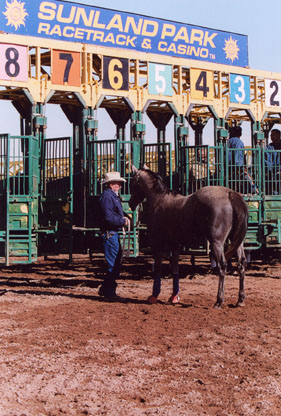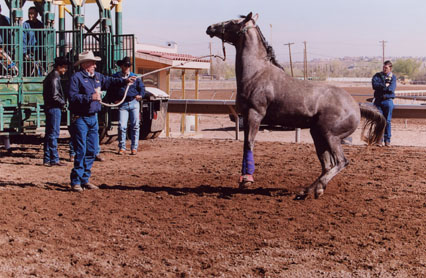Interviews and Community
Hunting For Help – Part 1
Written by Jennifer K. Hancock
This article appeared in Eclectic Horseman Issue No.6
Reprinted from the May 2002 issue of The American Quarter Horse Racing Journal. Ray Hunt offers a different approach to exasperating gate schooling.
The morning sun is rising, horses gallop around the oval, a few turn and work from the chute. And already frustration is building behind the starting gate. A thousand pounds of nervous horseflesh refuses to enter the cold steel walls of the narrow confining cage. Waving arms, kicked dirt, grabbed ears and even locked arms behind his tail can’t make the beast-which he is rapidly becoming-enter the gate.
The scene, which could be at any track on any morning, occurred at Sunland Park the first morning of the American Quarter Horse Association Starters Workshop. But attitudes-of horses and people-soon changed when master horseman Ray Hunt offered an alternative.

Hunt has shared his equine philosophy and techniques around the world and recently presented a two-day clinic at Sunland Park Racetrack and Frontera Training Center. Sponsored by AQHA’s Racing Department, the clinic focused on gate training young horses and correcting problem behavior in older runners.
“We’ve got to look at things a little more from the horse’s point of view, “Hunt says. “We’ve got to try to help him to learn to reach our goals.”
Hunt works with-instead of against-the horse’s natural sensitivities to pressure. He often points out that a horse can feel a single fly land on its body-so whips and chains aren’t necessary. He urges people to combine their knowledge and understanding of horses to create situations in which the wrong thing becomes difficult and the right thing simple.
“Make the wrong thing difficult and the right thing easy,” Hunt says.
Before the horse is even asked to enter the gate, Hunt establishes boundaries with the animal. While facing the horse, he applies slight pressure with the lead rope (enough to take the slack out) to encourage the horse to step forward. Hunt isn’t talking about walking off-he’s looking for the slightest clue that the horse is willing to move its foot. As soon as the horse shifts its body weight, Hunt releases the pressure.
“Think about controlling the feet and shifting the weight,” he says. “If you get the horse to move his weight, he’s got to shift his feet, but I bet he doesn’t move his feet first. He shifts his weight, then moves his feet. He prepares his position, and then there’s a transition. Don’t try to get the horse to go without getting it ready.”
If the horse steps as Hunt wanted, he is rewarded with a rub on the forehead. If the horse doesn’t step forward, the pressure is applied again, but never in a tug-of-war fashion. This isn’t a contest.
“The horse doesn’t know what a contest is-what win or lose is-but the human does,” Hunt explains. “The first thing you know, you’ve got the horse contesting you-and don t be surprised if he’s the winner. The horse doesn’t have any pride or ego-the two things that really get in a human’s way.”
If the horse steps back, Hunt steps back also, keeping the pressure steady but not increasing it. Hunt wants to make the wrong thing difficult, not necessarily impossible. He stresses that the horse has a choice-he can do the right thing the easy way or do the wrong thing and face difficult consequences. In this case, the easy option is for the horse to simply take a step forward. But if he steps back, Hunt goes with him-if Hunt stood his ground, when the horse hits the end of the line, the man will probably have a fight on his hands.
Ready and Willing
Stay with us, now. Hunt is not talking about letting the horse have his way. The same principles are used to get the horse to back, to lower its head, to walk around Hunt in a tight circle, all the time establishing a partnership.
“Getting the horse in the gate is easy when you get him ready,” Hunt says with confidence.
The trick is the when he’s ready part, as Hunt also emphasizes by not putting a time limit on the horse. His example of an artificial limit is trying to teach someone to work a math problem in say five minutes, when it might take the student seven minutes or even longer to understand. If you are patient for two more minutes, the student might master the skill, but if you get frustrated at five, then you have wasted your time and energy and depleted the confidence of the student. The same applies to a horse learning anything, in this case, loading in the gates.
Masters of Body Language
The horse’s body gives all the clues to his readiness. Hunt compares the unprepared horse to a steel rod. Tense muscles, wide eyes and planted feet are signs of excitement that show the horse needs more time to relax. Establishing discipline-getting the horse to move when asked, stop when commanded and respect the handler’s space-might take more than one training session and should be taught at the barn, rather than between the saddling paddock and post time. Creating trust between horse and handler is important when asking a horse to do anything as unnatural as loading in the gate.
“There has to be firmness and discipline,” Hunt says. “I’m responsible for running the show, and the horse is going to work for me. He’s going to go where I want him, but he’s not a slave. You make him want to do it. First thing you know, he’s your partner.”
After the horse relaxes, he’ll tell you when he’s ready to enter the gate. Hunt describes his willing subject as bendable. Most horses which are easily handled but not ready to accept the gate will walk up to the open stall, stop and shift their hindquarters out of line, making a smooth entrance into the gate impossible. Hunt suggests supporting the horse by twirling the end of the lead rope near or even tapping the horse’s hip to get the horse to line up. Then back the horse and approach the gate again to gauge the horse’s willingness. Don’t be surprised if you have to do this several times. As Hunt says, “It’ll probably take more than once but less than a million times.
“Notice the smallest changes and the slightest tries,” he stresses.
When the horse walks to the gate, reward the effort with a pet on the head or neck. If you ask the horse to step in the gate and he braces his legs, ask the horse to step to the side and then return in order to get movement back into the legs. This is a matter of life and quest.
“You direct the life in the horse’s body through the legs to the feet to the mind,” Hunt often says.
After the horse enters the gate, make it easy to stay-with encouragement by petting-but not impossible to leave. If the horse does step out, apply steady pressure to encourage the horse back in, or back completely out and try the approach again.
At this point, if the horse is partially in the gate, you might feel the urge to push the horse completely in the gate from behind. Resist the impulse. Leaving the gate quietly will not establish a bad habit, but forcing the horse at the least will accentuate the horse’s anxiety and might cause a wreck. Be patient, progress is being made.

“Slow down so you can hurry up,” says Hunt. “In the end, it’s a good way. Speed ahead of accuracy is no good.”
When you build on positive experiences, it increases the horse’s confidence. But it won’t just happen in one day.
“You fixed it so that it could happen,” Hunt explains.
Hunt also suggests implementing training aids at the barn, such as placing a cross tie or similar heavy post for the horse to step over to simulate the stabilizing bar on the starting gate.
“A lot of horses hate to step over that bar behind the starting gate,” Hunt reasons. “But if you just lay some ties down at the barn, he’ll get to picking up his feet and stepping over. It will become as natural as can be if we just do some of those simple things, like lead him through a narrow spot, and then put him away. It makes all the difference in the world for later on the track. You’re not running him yet or racing, you’re preparing him, getting him ready mentally and physically for it.”
Same scene, Day 2: Things are different this time. Open-minded handlers trying something different are having definite positive effects on the horses.
The new equation takes more time. But there is much less frustration.
This article appeared in Eclectic Horseman Issue No.6


